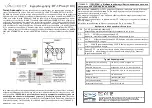
Table 31-1. SERCOM Modes
CTRLA.MODE
Description
0x0
USART with external clock
0x1
USART with internal clock
0x2
SPI in slave operation
0x3
SPI in master operation
0x4
I
2
C slave operation
0x5
I
2
C master operation
0x6-0x7
Reserved
For further initialization information, see the respective SERCOM mode chapters:
Related Links
SERCOM USART – SERCOM Universal Synchronous and Asynchronous Receiver and Transmitter
SERCOM SPI – SERCOM Serial Peripheral Interface
SERCOM I2C – SERCOM Inter-Integrated Circuit
on page 678
31.6.2.2. Enabling, Disabling, and Resetting
This peripheral is enabled by writing '1' to the Enable bit in the Control A register (CTRLA.ENABLE), and
disabled by writing '0' to it.
Writing ‘1’ to the Software Reset bit in the Control A register (CTRLA.SWRST) will reset all registers of
this peripheral to their initial states, except the DBGCTRL register, and the peripheral is disabled.
Refer to the CTRLA register description for details.
31.6.2.3. Clock Generation – Baud-Rate Generator
The baud-rate generator, as shown in
, generates internal clocks for asynchronous and
synchronous communication. The output frequency (f
BAUD
) is determined by the Baud register (BAUD)
setting and the baud reference frequency (f
ref
). The baud reference clock is the serial engine clock, and it
can be internal or external.
For asynchronous communication, the /16 (divide-by-16) output is used when transmitting, whereas the /1
(divide-by-1) output is used while receiving.
For synchronous communication, the /2 (divide-by-2) output is used.
This functionality is automatically configured, depending on the selected operating mode.
Atmel SAM L22G / L22J / L22N [DATASHEET]
Atmel-42402E-SAM L22G / L22J / L22N_Datasheet_Complete-07/2016
596
















































